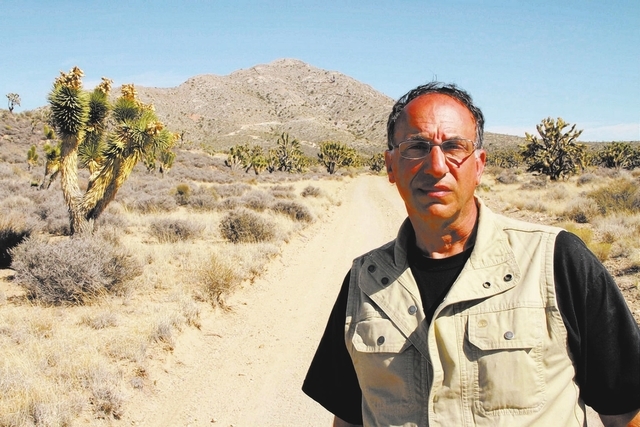
Ghost hunting — it isn’t what award winning documentary filmmaker Ted Faye originally set out to do.
He came to Death Valley enamored of its history, looking to tell the true stories of the people whose lives merged into this extreme landscape and were either transformed or utterly defeated by it.
What he hadn’t counted on was becoming equally intrigued by the stories of Death Valley’s ghosts, of its paranormal legends, stories that couldn’t be verified in historical documents and yet persisted over time and drew followers of their own. This September, 20 years and more than a dozen movies later, Faye found himself the guest of honor at the first ever Weird Tales Film Festival in Ridgecrest, Calif., named for his own Death Valley Weird Tales film series.
The highlight of the event was the premiere of “The Desert’s Lost River of Gold,” the sixth in the Weird Tales paranormal history and adventure series by Faye’s production company Gold Creek Films.
“When you’re doing the real history,” Faye says, “you can’t help but bump into all of these other stories.”
For instance, as he went about making his first historical documentary films in the 1990s, he kept coming upon “the perpetual notion that there was an underground civilization beneath Death Valley.” From the Native American stories to the Manson Family mythology, the idea kept surfacing for Faye and coalesced into the first Weird Tales video, “Death Valley’s Ancient Underground.”
Over the course of the past two decades, Faye’s storytelling has shifted in content and tone, but the desert focus has remained. Beginning with “Death Valley Memories” in 1994, Faye made a series of documentaries about “these crazy miners, these pioneers, the mules, the guys walking around dying in the desert.” He was captivated by the grandeur and the extremity, the contrast of barren landscape and its promise of luxurious wealth.
“Memories,” he says, was a compilation of the recollections of many individuals who were alive during the time mining history was being made in Death Valley. It was put together with the best of Faye’s LA entertainment know-how (earned from working on music videos with bands such as Huey Lewis and the News). He found corporate sponsorship to get the project started, managed to get former President Ronald Reagan on board to do an introduction, Eddie Albert to narrate, showed it at a Death Valley 49er encampment and won the hearts and minds of every Death Valley enthusiast who saw it.
That set the hiking boots of this Pennsylvania born, LA glam industry filmmaker firmly on the path less chosen, the path that would take him, and Gold Creek producer and camera man Jamie Hall, to the far corners of the desert searching for stories and the people who hold them.
About seven years ago, Faye, who calls himself a “ghost agnostic,” gave in to the lure of those ‘other’ stories, the ones that, as a serious researcher and filmmaker, he was supposed to ignore. “Some people don’t appreciate the weirdness,” Faye says. “They say Death Valley’s not weird. But I say, it’s named Death, for crying out loud!”
Faye’s first Weird Tales film marked a transition from the more formal historical documentary form. In this series, Faye appears as the host, taking the viewer along on his quest for answers about the legends that haunt Death Valley and the desert region. From a chilling behind the scenes ghost tour of Marta Becket’s Amargosa Opera House and Hotel, to the harrowing climb up into the inside peak of Kokoweef Mountain, Faye’s intrepid search for the supernatural leads him to as many new questions as it does answers.
“The Desert’s Lost River of Gold” tells the story of a fabled underground river that rushes between banks of black sand salted with heavy nuggets of gold. In it, Faye interviews a treasure seeker who spent years digging through Kokoweef Mountain, believed to be the gateway under which the river runs, trying to break through to that gold. “My focus has always been on the people,” Faye says. “Not only the people who made the history but the people who follow it, the energy, the resources, the lives spent looking for these legends. That creates its own powerful history on the ground.”
If there is one thing Faye has learned in following the ghost trails, it is that “belief is a powerful thing,” he says.
This year’s first-ever Weird Tales Film Festival drew about a hundred people and included ghost and treasure hunts for the enthusiastic crowd in Ridgecrest, a Death Valley gateway town. Plans are already underway to hold another festival next September, says Faye, and he hopes to see it “Grow into something, maybe our own version of Burning Man.”
It has also become tradition over the years for Faye to show or premiere each new film at the Death Valley 49er encampment that takes place in the National Park every November. The 49ers were among Faye’s first sponsors in his Death Valley venture, he says, and continue to lend their support to his projects. “The Desert’s Lost River of Gold” was scheduled to show at this year’s encampment in the Furnace Creek Visitor Center Auditorium.